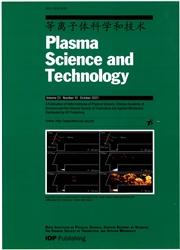熔渣激光诱导击穿光谱特性研究
IF 1.8
3区 物理与天体物理
Q3 PHYSICS, FLUIDS & PLASMAS
引用次数: 0
摘要
摘要快速在线分析液渣对优化钢铁生产质量和能源效率至关重要。为了研究影响激光诱导击穿光谱(LIBS)在线测量精渣的关键因素,本研究考察了渣成分和温度对LIBS光谱强度和稳定性的影响。实验温度控制在1350、1400和1450°C三个水平。结果表明,炉渣成分和温度显著影响LIBS谱的强度和稳定性。随着炉渣中铁含量和温度的升高,炉渣的黏度降低,LIBS光谱的强度和稳定性增强。此外,42个精炼矿渣样品在1350、1400和1450°C下定量分析了Fe、Si、Ca、Mg、Al和Mn。采用归一化全光谱结合偏最小二乘(PLS)定量建模 ,以Ca II 317.91 nm谱线为内标。结果表明,采用内标归一化方法可以显著降低光谱波动的影响。同时,发现温度在1450℃时比在1350℃和1400℃时效果更好,有利于在渣处于低粘度的水态时进行定量分析。本文章由计算机程序翻译,如有差异,请以英文原文为准。
Characteristics of laser-induced breakdown spectroscopy of liquid slag
Abstract Rapid online analysis of liquid slag is essential for optimizing the quality and energy 
efficiency of steel production. To investigate the key factors that affect the online measurement of 
refined slag using laser-induced breakdown spectroscopy (LIBS), this study examined the effects 
of slag composition and temperature on the intensity and stability of the LIBS spectra. The 
experimental temperature was controlled at three levels: 1350, 1400, and 1450 °C. The results 
showed that slag composition and temperature significantly affected the intensity and stability of 
the LIBS spectra. Increasing the Fe content and temperature in the slag reduces its viscosity, 
resulting in an enhanced intensity and stability of the LIBS spectra. Additionally, 42 refined slag 
samples were quantitatively analyzed for Fe, Si, Ca, Mg, Al, and Mn at 1350, 1400, and 1450 °C. 
The normalized full spectrum combined with partial least squares (PLS) quantification modeling 
was used, using the Ca II 317.91 nm spectral line as an internal standard. The results show that using the internal standard normalization method can significantly reduce the influence of spectral 
fluctuations. Meanwhile, a temperature of 1450 °C has been found to yield superior results 
compared to both 1350 and 1400 °C, and it is advantageous to conduct a quantitative analysis of 
the slag when it is in a water-like state with low viscosity.
求助全文
通过发布文献求助,成功后即可免费获取论文全文。
去求助
来源期刊

Plasma Science & Technology
物理-物理:流体与等离子体
CiteScore
3.10
自引率
11.80%
发文量
3773
审稿时长
3.8 months
期刊介绍:
PST assists in advancing plasma science and technology by reporting important, novel, helpful and thought-provoking progress in this strongly multidisciplinary and interdisciplinary field, in a timely manner.
A Publication of the Institute of Plasma Physics, Chinese Academy of Sciences and the Chinese Society of Theoretical and Applied Mechanics.
 求助内容:
求助内容: 应助结果提醒方式:
应助结果提醒方式:


